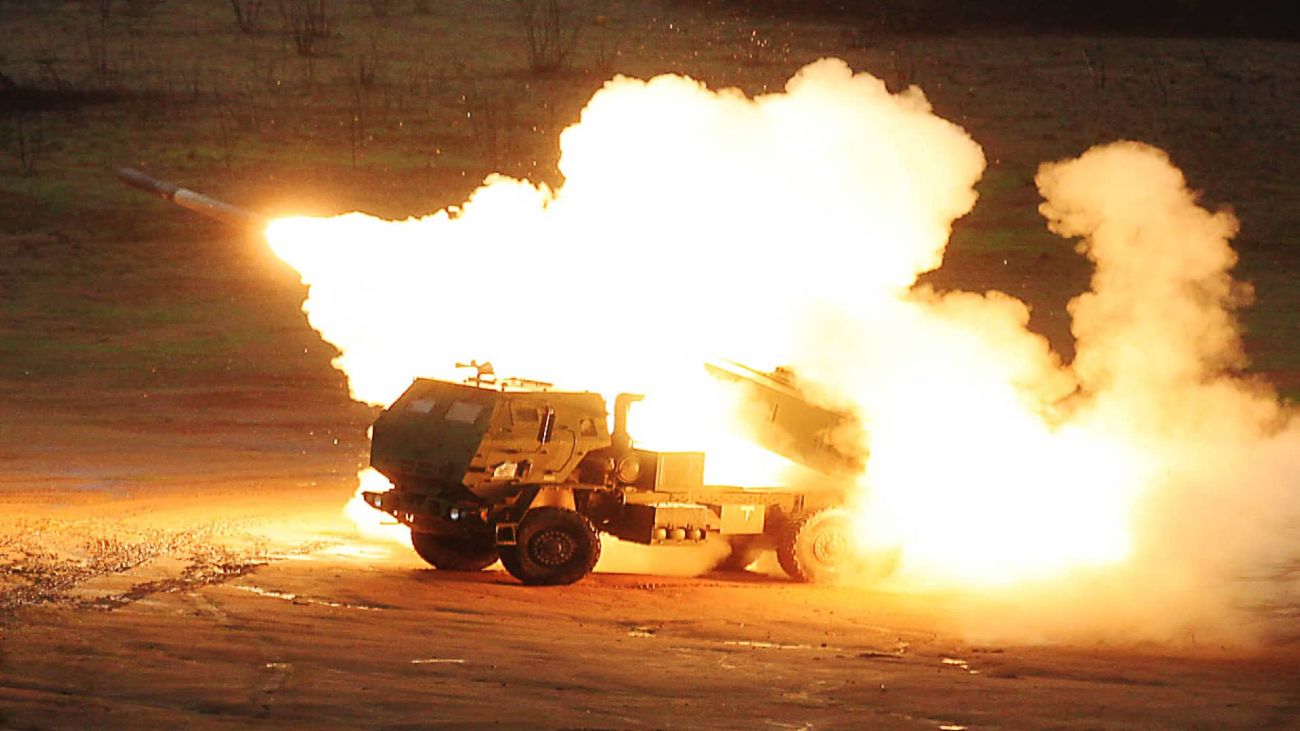Few American weapon systems have performed as well in Ukraine as the High Mobility Artillery Rocket System (HIMARS). Now, a crucial upgrade to these truck-based missile launchers could enhance their utility in another potential conflict—one with China in the Indo-Pacific region.
The upgrade to this decades-old mobile artillery system could enhance its range and precision, as well as allow it to hit moving targets, such as ships in the Pacific Ocean.
This could prove a game-changer in a potential conflict with China over Taiwan, where the longer-range rockets could allow the US and its regional allies to control key waterways around Taiwan.
The new rockets, called PrSM (Precision Strike Missile), have been jointly developed by the US and Australia, and were fired for the first time in Australia last week during the multinational exercise Talisman Sabre 2025.
The PrSM was fired from a recently acquired M142 High Mobility Artillery Rocket Systems (HIMARS) at the Mount Bundey Training Area, located in the Northern Territory.
Notably, both the PrSM and HIMARS systems have been delivered to Australia ahead of schedule.
“From delivering HIMARS ahead of schedule to delivering and testing PrSM ahead of schedule, the Albanese Government is modernising the Australian Army at speed…This successful launch is a significant milestone in the Government’s plan to deliver a twenty-five-fold increase to the Army’s long-range strike capability,” the Australian Minister for Defense Industry Pat Conroy said.
Not every day do you get to see our Defence Force make history.
But Friday was one of those days.
It was the first time the @AustralianArmy has test-fired a Precision Strike Missile in Australia.
And it’s only the 16th test firing of its kind in the world. pic.twitter.com/qrZvGyZDsM
— Pat Conroy MP (@PatConroy1) July 28, 2025
According to the Australian Ministry of Defense, the missile struck a ship located more than 300 kilometers away in just four minutes and three seconds, confirming the system’s precision and rapid impact capabilities. The launch was executed by personnel from the 14th Regiment of the 10th Artillery Brigade as part of the biennial Talisman Sabre 2025 exercise.
The missile hit within 3 feet of the target point, the Australian military officials said.
“This is all about extending deterrence in the Indo-Pacific, all about signaling to any potential adversary that pain can be inflicted,” Conroy added.
Australia has ordered 42 M142 HIMARS as part of Australia’s National Defense Strategy, which seeks to enhance fire support, mobility, and long-range strike capabilities.
These HIMARS will be equipped with GMLRS-AW guided rockets and the PrSM ballistic missiles, which will replace the US Army’s current Army Tactical Missile System (ATACMS).
The event marked the first time the upgraded PrSM missile was fired by a US ally.
The PrSM Has China In Its Sight
The upgraded PrSM ballistic missile offers significant advantages over the ATACMS, which have proved their lethality in the Ukraine War.
The PrSM missile has an extended range of 310 miles (500 km), compared with a range of about 190 miles (300 km) for the older ATACMS missiles.
Furthermore, each launch pod will be able to hold two PrSM missiles, instead of just one in the case of ATACMS, essentially doubling the firepower of HIMARS.
Additionally, the PrSM will be far less susceptible to jamming.
However, the most significant capability boost will be the PrSM’s ability to hit moving ships. Currently, the PrSM missiles are equipped with an inertial navigation system; however, future models are planned to have seeker modes for hitting moving targets on land and sea.

Notably, in June last year, the US Army successfully tested its Precision Strike Missile (PrSM) against a moving maritime target in the Pacific.
The test, carried out during a sinking exercise (SINKEX), targeted the decommissioned hulk of the ex-USS Cleveland, an Austin-class amphibious transport dock. This was the first known use of the PrSM against a moving sea target and the first time PrSM was employed outside of the United States.
Earlier in January 2024, the US Army tested the seeker technology that will allow the PrSM to strike warships and moving targets, clearing the path for the Increment II PrSM to acquire anti-ship abilities.
The ability to hit moving maritime targets will be a crucial advantage in the Pacific, where the US allies could deploy the highly mobile HIMARS to strike Chinese ships from afar.
This could pose a formidable challenge to China in case it tries to invade Taiwan by crossing the Taiwan Strait, or attempts to enforce a blockade of Taiwan using its huge Navy.
Notably, the Taiwan Strait is just 160 km wide at its narrowest point. At its widest point, the Taiwan Strait is only 350 km wide, which means that the HIMARS deployed in Taiwan can hit Chinese ships with the PrSM missiles at any point in the Taiwan Strait.
Taiwan has received 11 M142 High Mobility Artillery Rocket Systems (HIMARS) as of November 2024 and has ordered a total of 29 HIMARS. The initial batch of 11 systems arrived in late 2024, with the remaining 18 scheduled for delivery by 2026, a year ahead of the original 2027 timeline.
Going forward, the missile’s range could eventually extend to around 620 miles (1,000 km) in later models, allowing Taiwan to hit a large part of mainland China (especially Fujian province) from Taiwan itself.
The small size of HIMARS offers other advantages. They could be hidden in buildings or under the trees. Further, they can engage in a ‘shoot and scoot’ strategy to escape counter-battery fire.
In April this year, Lockheed Martin, the manufacturer of PrSM missiles, got funding of USD 4.94 billion for an indefinite delivery, indefinite quantity (IDIQ) contract to produce PrSM missiles.

Australia has also joined the US in jointly producing the PrSM missiles. Eventually, Australia could produce these PrSM missiles domestically, the Wall Street Journal reported.
Land-based mobile missile launchers are increasingly becoming important in the US strategy to counter China in the Indo-Pacific region. The truck-mounted HIMARS with upgraded PrSM missiles is just one component of this strategy.
Earlier this month, the US Army fired its mid-range missile system, Typhon, from Australia for the first time, striking a maritime target during the Talisman Sabre exercise.
The Typhon system, operated by the Hawaii-based 3rd Multi-Domain Task Force, launched an SM-6 missile from the Bradshaw Training Area. The system, which includes launchers, missiles, and a battery operations center, is capable of firing both SM-6 and Tomahawk missiles.
Similarly, in July, the US deployed its NMESIS missile system (another truck-mounted mobile anti-ship missile system) to the Philippines for the Balikatan 2025 exercises.
“The NMESIS was deployed during Balikatan and took part in battle drills,” the Pacific Fleet spokesperson has said.
Notably, HIMARS also took part in the Balikatan 2025 exercise.
The upgraded PrSM missiles will add more lethality to US forces and their allies in the Indo-Pacific region.
- Sumit Ahlawat has over a decade of experience in news media. He has worked with Press Trust of India, Times Now, Zee News, Economic Times, and Microsoft News. He holds a Master’s Degree in International Media and Modern History from the University of Sheffield, UK.
- VIEWS PERSONAL OF THE AUTHOR.
- He can be reached at ahlawat.sumit85 (at) gmail.com




